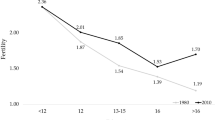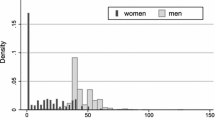Abstract.
Economic models of household behavior typically yield the prediction that increases in schooling levels and wage rates of married women lead to increases in their labor supply and reductions in fertility. In Italy, low labor market participation rates of married women are observed together with low birth rates. Our explanation involves the Italian institutional structure, particularly as reflected in rigidities and imperfections in the labor market and characteristics of the publicly-funded child care system. These rigidities tend to simultaneously increase the costs of having children and to discourage the labor market participation of married women. We analyze a model of labor supply and fertility, using panel data. The empirical results show that the availability of child care and part time work increase both the probability of working and having a child.
Similar content being viewed by others
Author information
Authors and Affiliations
Additional information
Received: 14 February 2000/Accepted: 20 February 2001
Rights and permissions
About this article
Cite this article
Del Boca, D. The effect of child care and part time opportunities on participation and fertility decisions in Italy. J Popul Econ 15, 549–573 (2002). https://doi.org/10.1007/s001480100089
Issue Date:
DOI: https://doi.org/10.1007/s001480100089




